Abstract
1. Effects of electrical stimulation of hypothalamic ventromedial nucleus (v.m.n.) on the lordosis reflex of female rats were examined in ovariectomized and oestrogen-primed animals with chronically implanted electrodes. 2. Lordosis triggered either by manual cutaneous stimulation or by male mounting, was facilitated by electrical stimulation of the v.m.n. 3 A gradual increase in lordosis performance followed a relatively long period of stimulation; never less than 15 min and usually about 1 hr of stimulation was necessary for maximum facilitation. Following the termination of stimulation, the performance returned gradually to the control level during a 5--8 hr period. 4. The optimal frequency of stimulation was between 10 and 30 Hz. Threshold for effective facilitation was, on the average, 12.5 microA. 5. Stimulation tended to induce larger facilitation when applied to the lateral side of v.m.n. 6. Pre-treatment with oestrogen was necessary to obtain facilitation by v.m.n. stimulation. The threshold dosage of oestrogen was 2.5 microgram per animal. 7. Stimulation was effective in adrenalectomized rats, in dexamethasone-primed animals, and in rats pre-treated with exogenous progesterone. Thus, adrenal prodesterone release is not required for the v.m.n. facilitation of lordosis. 8. Medial preoptic stimulation with the same parameters suppressed the lordosis reflex. 9. The v.m.n. participates in the control of lordosis by a facilitatory output. The delay before facilitation implies that the v.m.n. is not in the direct reflex-arc for the execution of lordosis. Rather, a summation or interaction process with an unusually long time course is involved.
Full text
PDF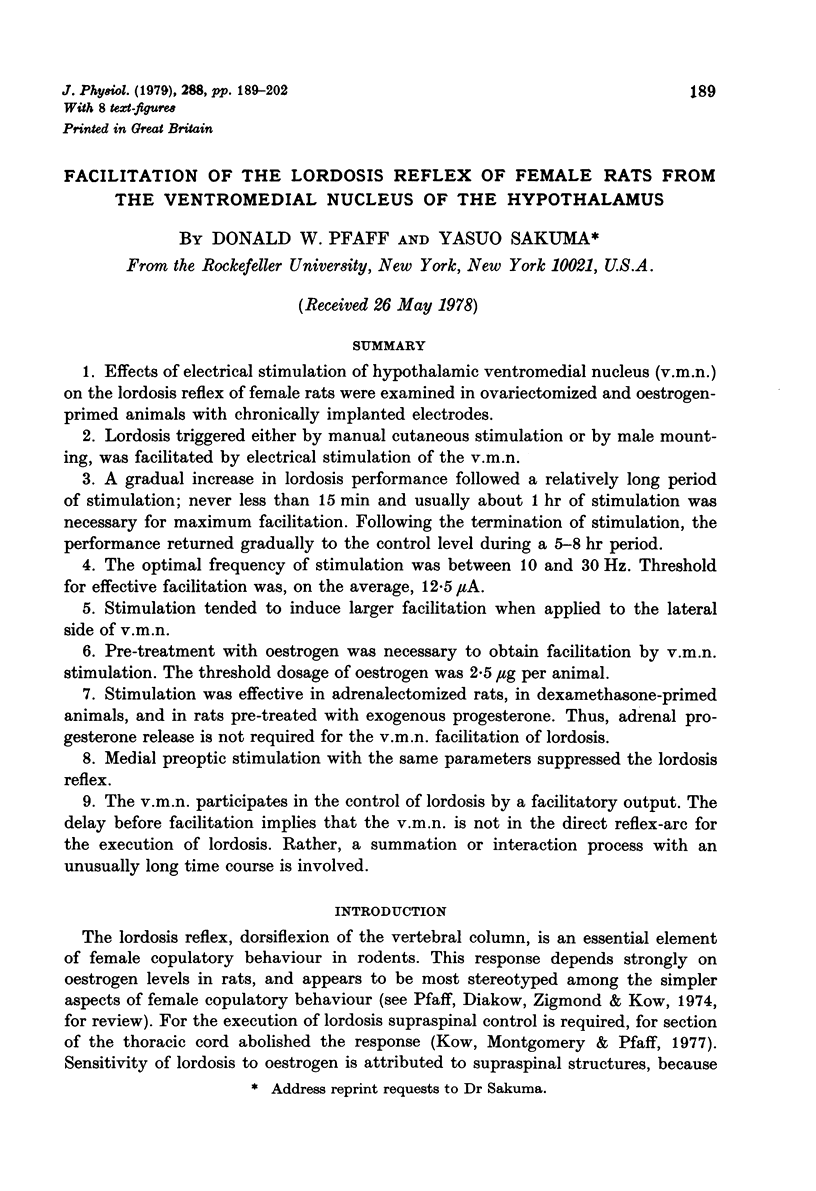
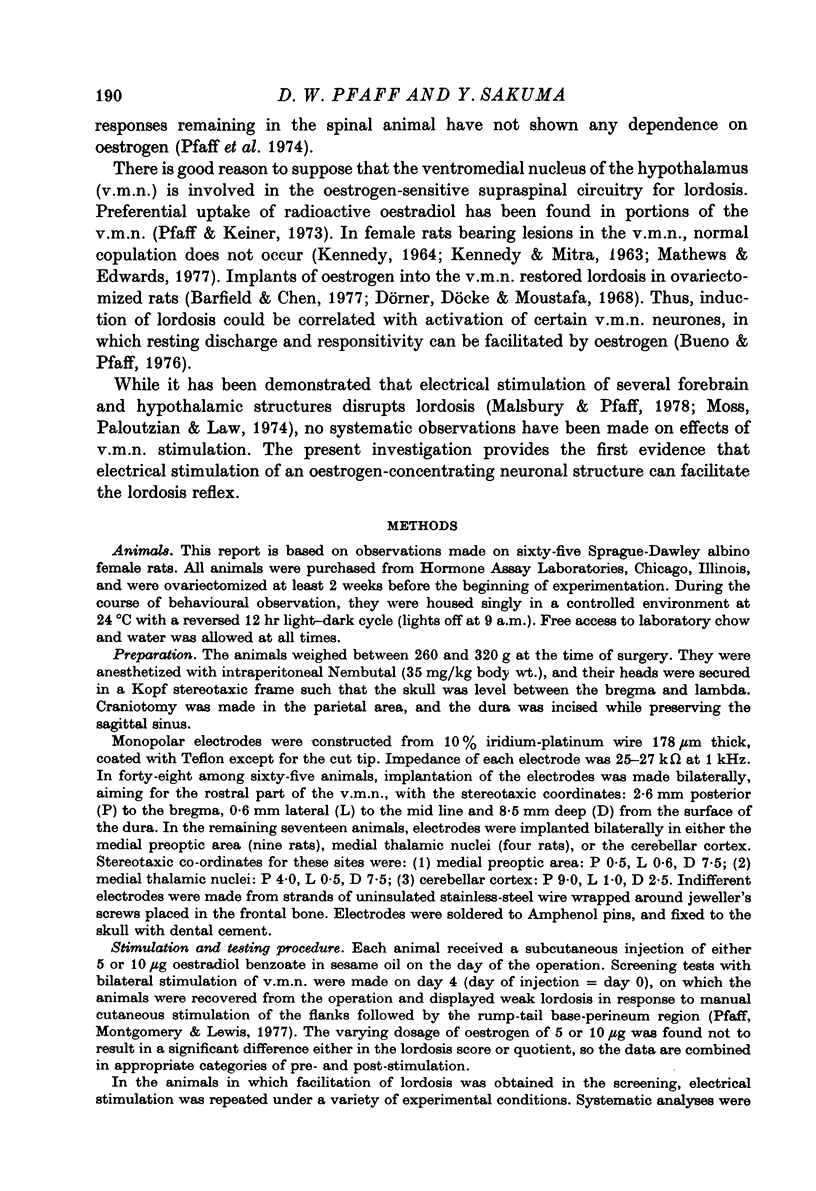
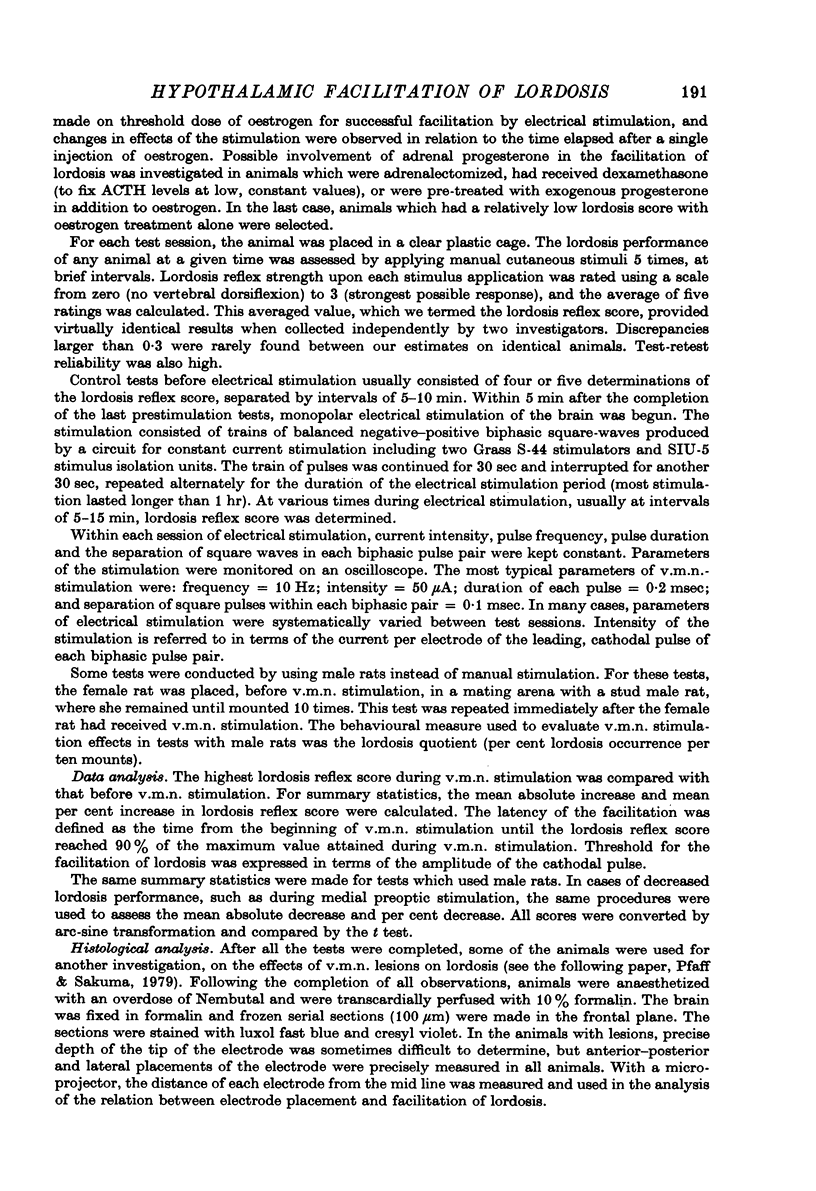
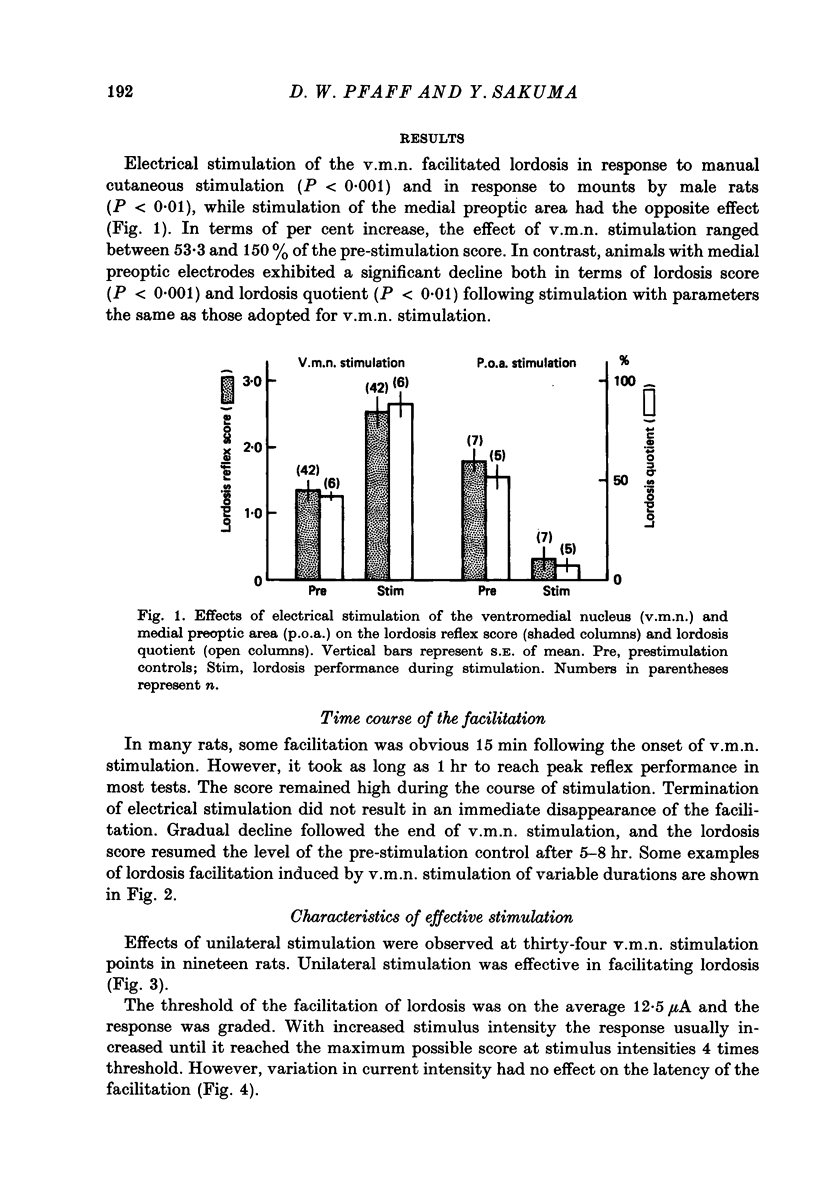
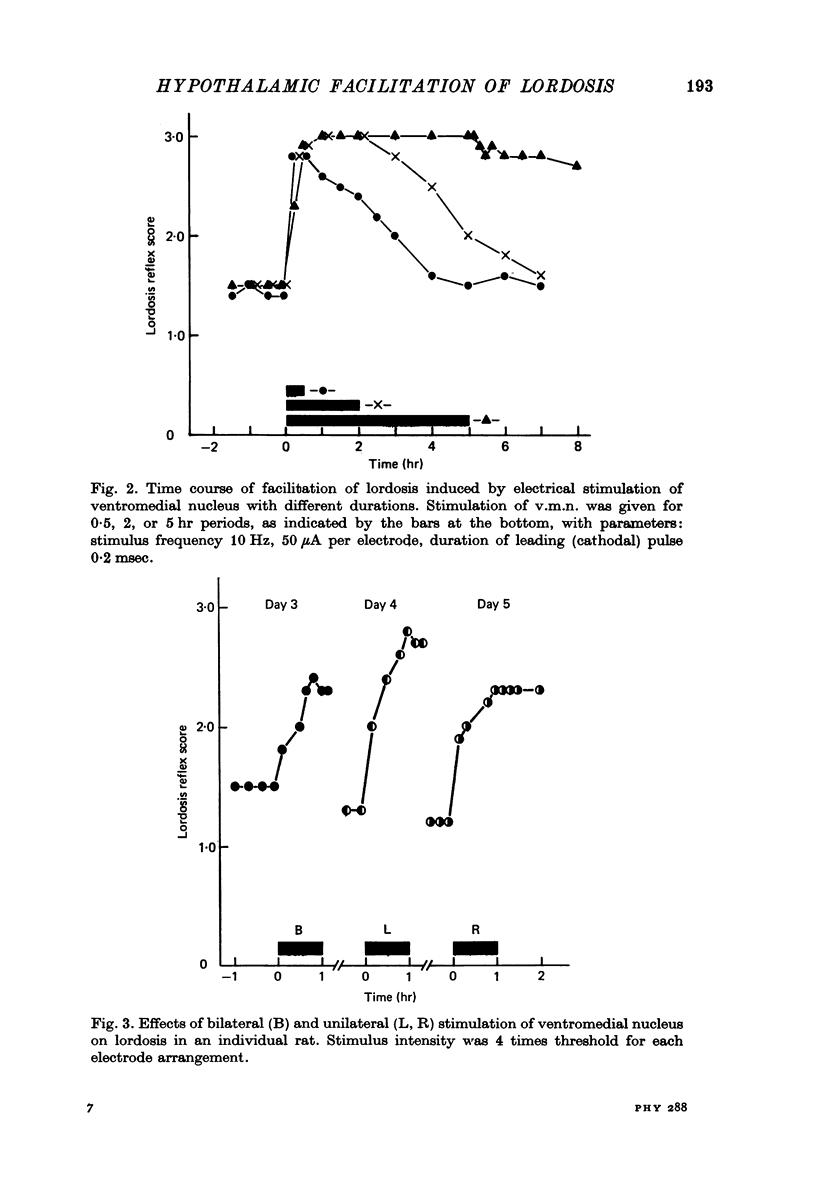
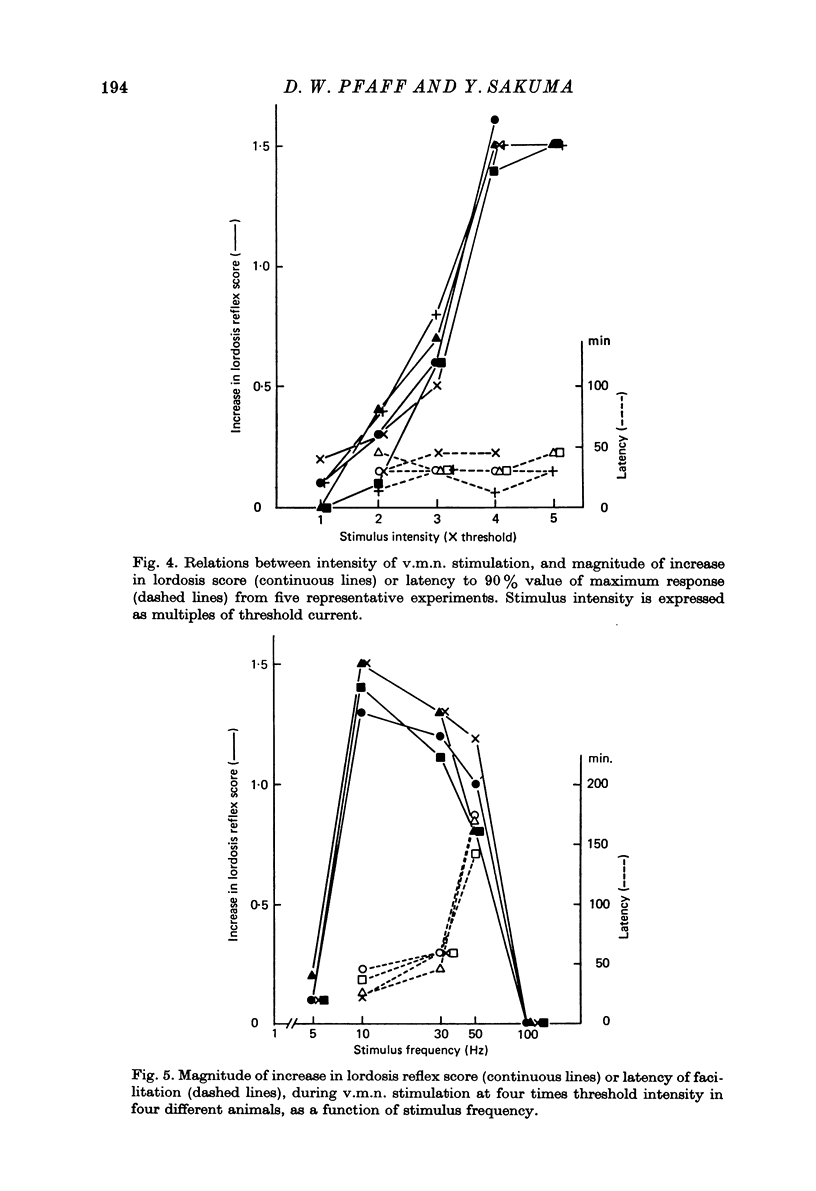

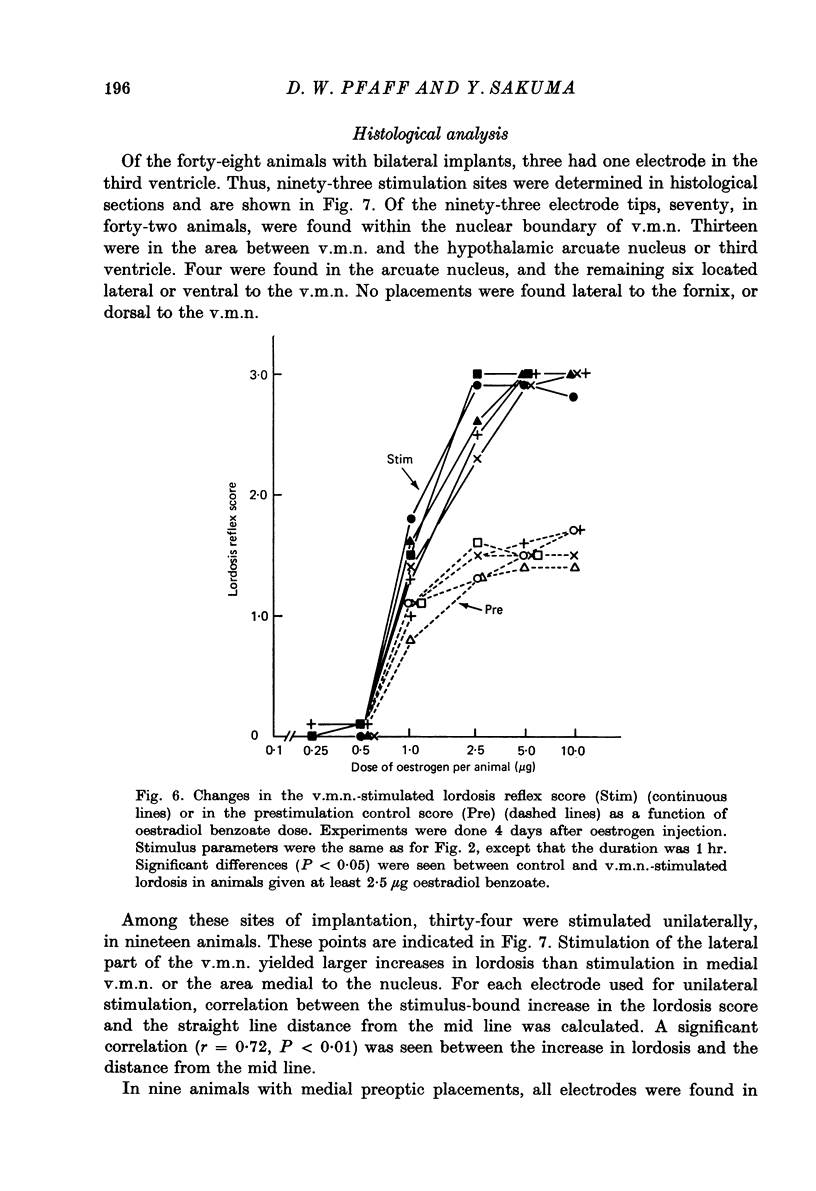
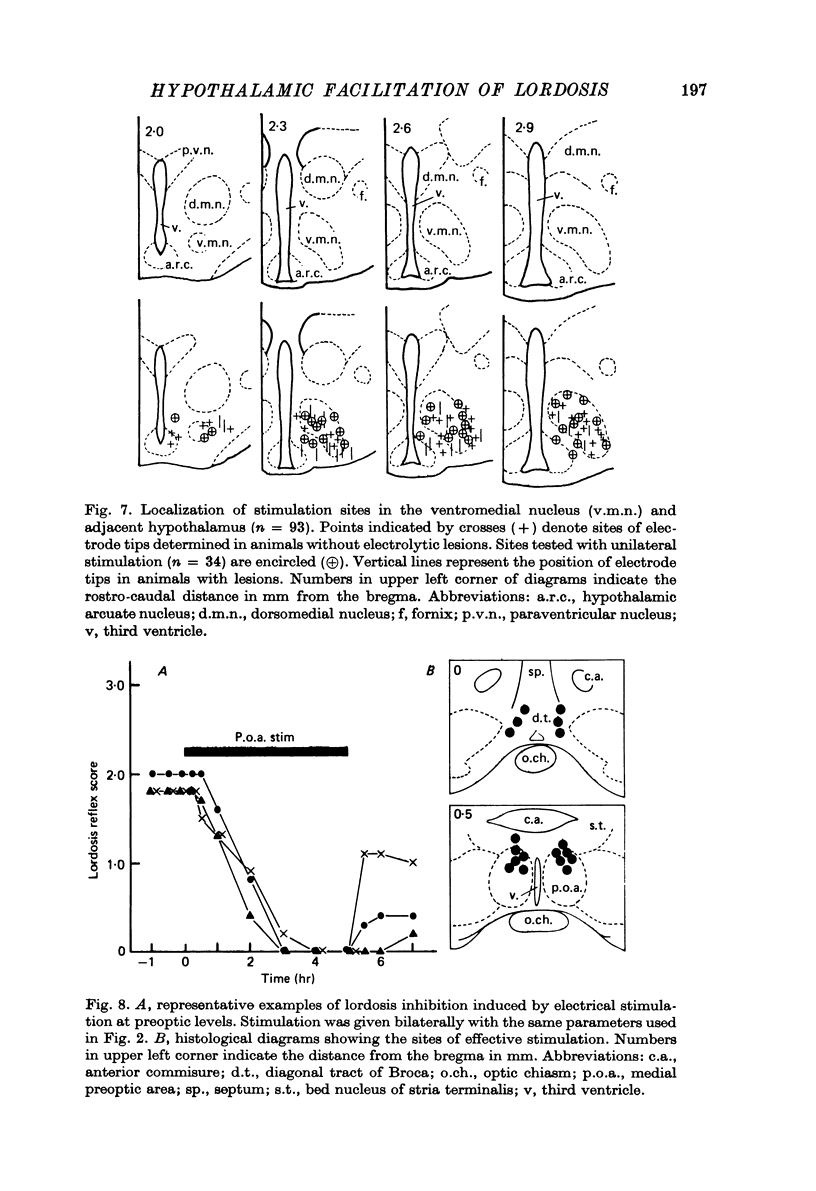
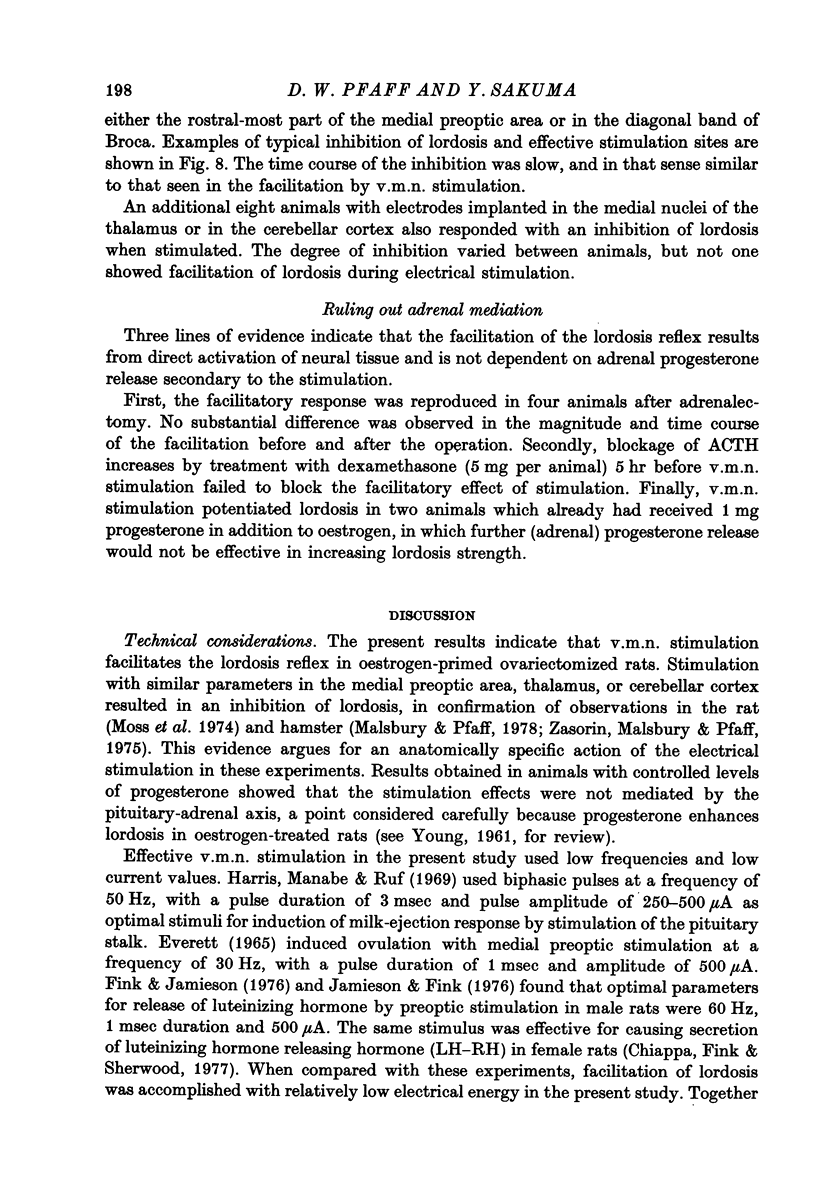
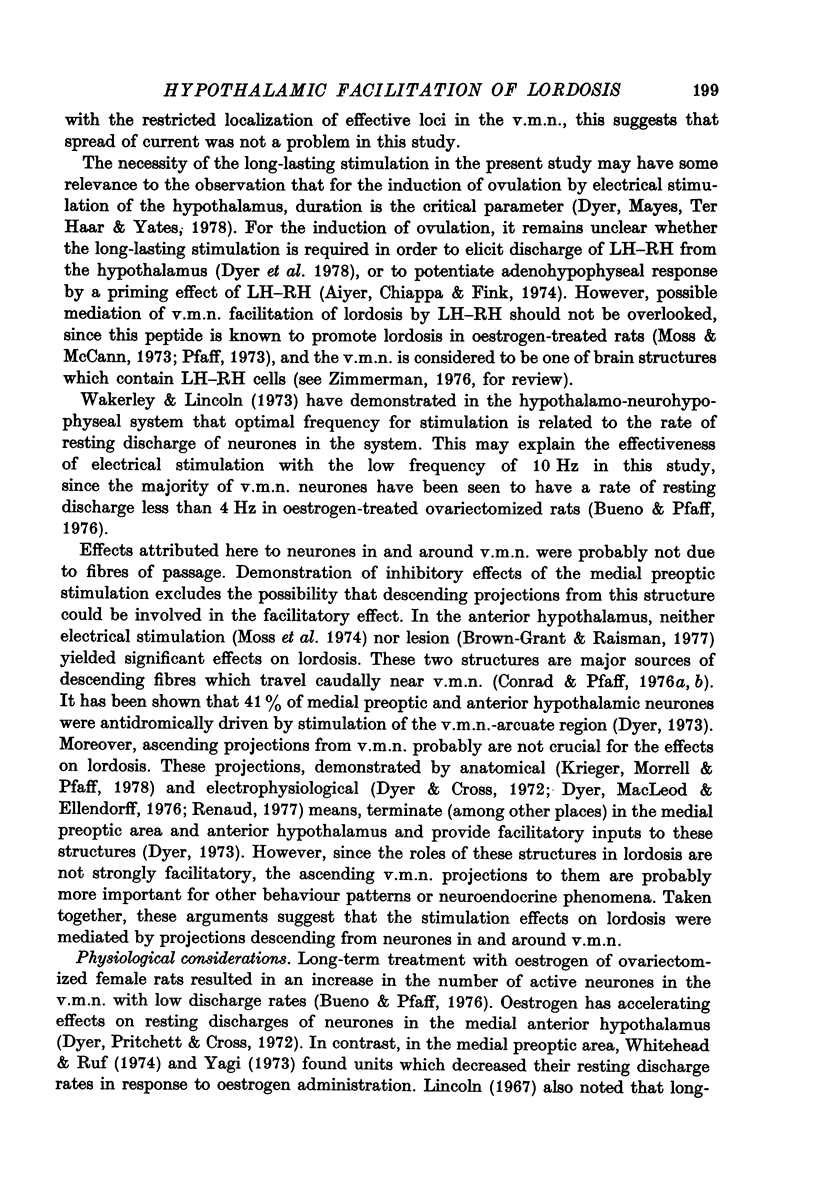
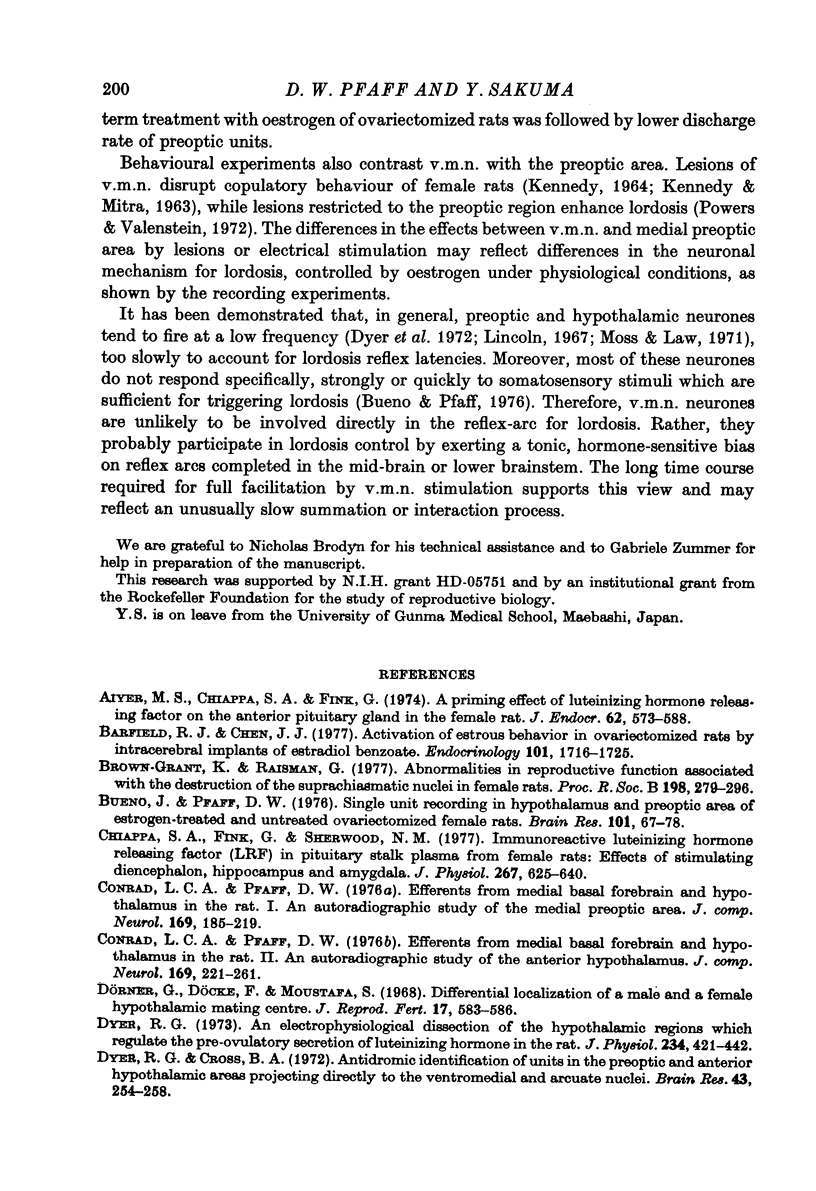
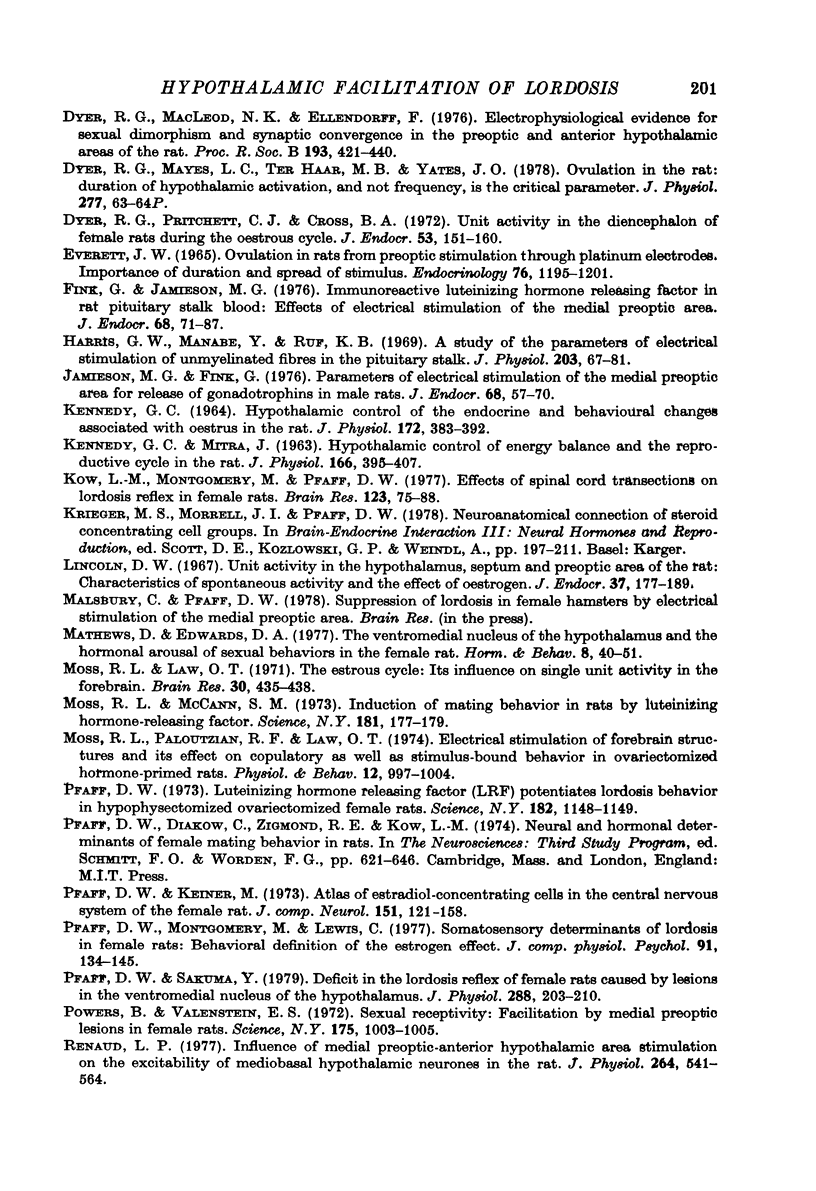
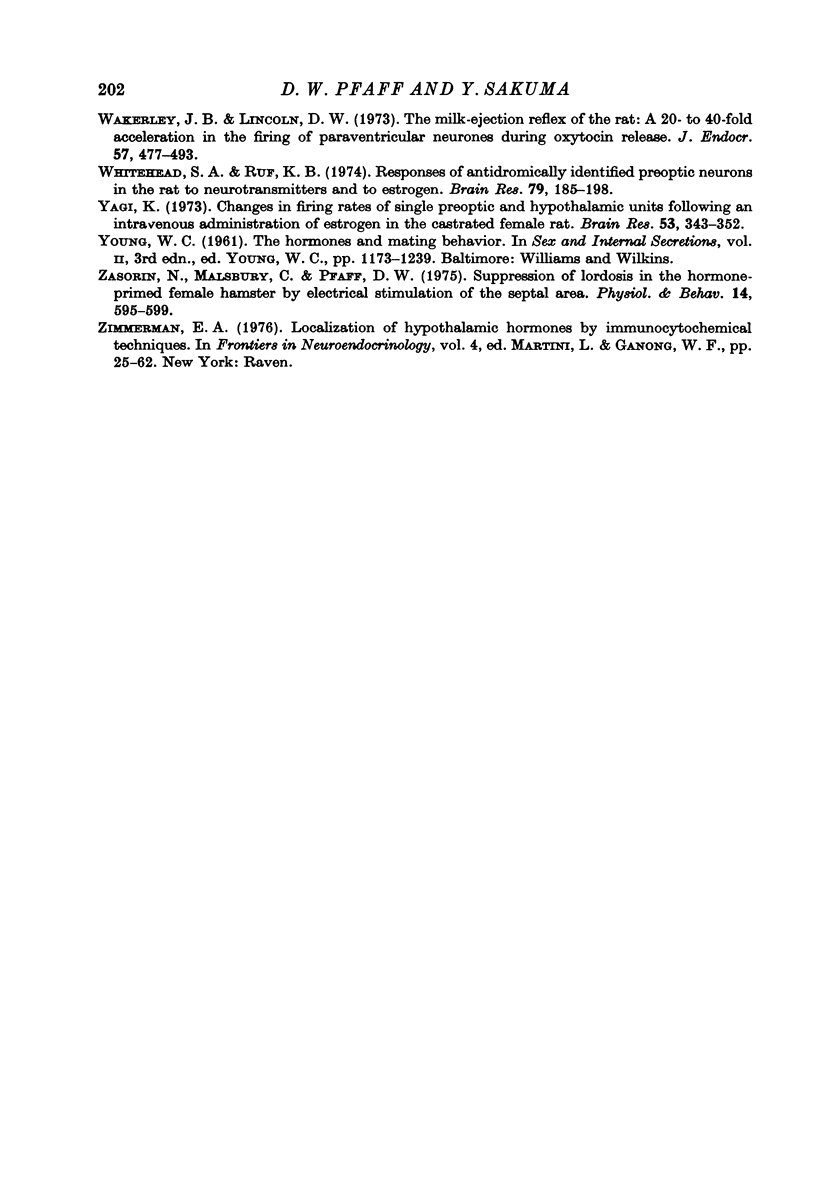
Selected References
These references are in PubMed. This may not be the complete list of references from this article.
- Aiyer M. S., Chiappa S. A., Fink G. A priming effect of luteinizing hormone releasing factor on the anterior pituitary gland in the female rat. J Endocrinol. 1974 Sep;62(3):573–588. doi: 10.1677/joe.0.0620573. [DOI] [PubMed] [Google Scholar]
- Bueno J., Pfaff D. W. Single unit recording in hypothalamus and preoptic area of estrogen-treated and untreated ovariectomized female rats. Brain Res. 1976 Jan 9;101(1):67–78. doi: 10.1016/0006-8993(76)90988-4. [DOI] [PubMed] [Google Scholar]
- Dyer R. G. An electrophysiological dissection of the hypothalamic regions which regulate the pre-ovulatory secretion of luteinizing hormone in the rat. J Physiol. 1973 Oct;234(2):421–442. doi: 10.1113/jphysiol.1973.sp010352. [DOI] [PMC free article] [PubMed] [Google Scholar]
- Dyer R. G., Cross B. A. Antidromic identification of units in the preoptic and anterior hypothalamic areas projecting directly to the ventromedial and arcuate nuclei. Brain Res. 1972 Aug 11;43(1):254–258. doi: 10.1016/0006-8993(72)90291-0. [DOI] [PubMed] [Google Scholar]
- Dyer R. G., MacLeod N. K., Ellendorff F. Electrophysiological evidence for sexual dimorphism and synaptic convergence in the preoptic and anterior hypothalamic areas of the rat. Proc R Soc Lond B Biol Sci. 1976 Jun 30;193(1113):421–440. doi: 10.1098/rspb.1976.0055. [DOI] [PubMed] [Google Scholar]
- Dyer R. G., Pritchett C. J., Cross B. A. Unit activity in the diencephalon of female rats during the oestrous cycle. J Endocrinol. 1972 Apr;53(1):151–160. doi: 10.1677/joe.0.0530151. [DOI] [PubMed] [Google Scholar]
- Dörner G., Döcke F., Moustafa S. Differential localization of a male and a female hypothalamic mating centre. J Reprod Fertil. 1968 Dec;17(3):583–586. doi: 10.1530/jrf.0.0170583. [DOI] [PubMed] [Google Scholar]
- Fink G., Jamieson M. G. Immunoreactive luteinizing hormone releasing factor in rat pituitary stalk blood: effects of electrical stimulation of the medial preoptic area. J Endocrinol. 1976 Jan;68(1):71–87. doi: 10.1677/joe.0.0680071. [DOI] [PubMed] [Google Scholar]
- Harris G. W., Manabe Y., Ruf K. B. A study of the parameters of electrical stimulation of unmyelinated fibres in the pituitary stalk. J Physiol. 1969 Jul;203(1):67–81. doi: 10.1113/jphysiol.1969.sp008850. [DOI] [PMC free article] [PubMed] [Google Scholar]
- Jamieson M. G., Fink G. Parameters of electrical stimulation of the medial preoptic area for release of gonadotrophins in male rats. J Endocrinol. 1976 Jan;68(1):57–70. doi: 10.1677/joe.0.0680057. [DOI] [PubMed] [Google Scholar]
- KENNEDY G. C. HYPOTHALAMIC CONTROL OF THE ENDOCRINE AND BEHAVIOURAL CHANGES ASSOCIATED WITH OESTRUS IN THE RAT. J Physiol. 1964 Aug;172:383–392. doi: 10.1113/jphysiol.1964.sp007426. [DOI] [PMC free article] [PubMed] [Google Scholar]
- KENNEDY G. C., MITRA J. Hypothalamic control of energy balance and the reproductive cycle in the rat. J Physiol. 1963 Apr;166:395–407. doi: 10.1113/jphysiol.1963.sp007111. [DOI] [PMC free article] [PubMed] [Google Scholar]
- Kow L. M., Montgomery M. O., Pfaff D. W. Effects of spinal cord transections on lordosis reflex in female rats. Brain Res. 1977 Mar 4;123(1):75–88. doi: 10.1016/0006-8993(77)90644-8. [DOI] [PubMed] [Google Scholar]
- Lincoln D. W. Unit activity in the hypothalamus, septum and preoptic area of the rat: characteristics of spontaneous activity and the effect of oestrogen. J Endocrinol. 1967 Feb;37(2):177–189. doi: 10.1677/joe.0.0370177. [DOI] [PubMed] [Google Scholar]
- Mathews D., Edwards D. A. The ventromedial nucleus of the hypothalamus and the hormonal arousal of sexual behaviors in the female rat. Horm Behav. 1977 Feb;8(1):40–51. doi: 10.1016/0018-506x(77)90019-8. [DOI] [PubMed] [Google Scholar]
- Moss R. L., Law O. T. The estrous cycle: its influence on single unit activity in the forebrain. Brain Res. 1971 Jul 23;30(2):435–438. doi: 10.1016/0006-8993(71)90097-7. [DOI] [PubMed] [Google Scholar]
- Moss R. L., McCann S. M. Induction of mating behavior in rats by luteinizing hormone-releasing factor. Science. 1973 Jul 13;181(4095):177–179. doi: 10.1126/science.181.4095.177. [DOI] [PubMed] [Google Scholar]
- Moss R. L., Paloutzian R. F., Law O. T. Electrical stimulation of forebrain structures and its effect on copulatory as well as stimulus-bound behavior in ovariectomized hormone-primed rats. Physiol Behav. 1974 Jun;12(6):997–1004. doi: 10.1016/0031-9384(74)90147-4. [DOI] [PubMed] [Google Scholar]
- Pfaff D., Montgomery M., Lewis C. Somatosensory determinants of lordosis in female rats: behavioral definition of the estrogen effect. J Comp Physiol Psychol. 1977 Feb;91(1):134–145. doi: 10.1037/h0077305. [DOI] [PubMed] [Google Scholar]
- Powers B., Valenstein E. S. Sexual receptivity: facilitation by medial preoptic lesions in female rats. Science. 1972 Mar 3;175(4025):1003–1005. doi: 10.1126/science.175.4025.1003. [DOI] [PubMed] [Google Scholar]
- Renaud L. P. Influence of medial preoptic-anterior hypothalamic area stimulation of the excitability of mediobasal hypothalamic neurones in the rat. J Physiol. 1977 Jan;264(2):541–564. doi: 10.1113/jphysiol.1977.sp011682. [DOI] [PMC free article] [PubMed] [Google Scholar]
- Wakerley J. B., Lincoln D. W. The milk-ejection reflex of the rat: a 20- to 40-fold acceleration in the firing of paraventricular neurones during oxytocin release. J Endocrinol. 1973 Jun;57(3):477–493. doi: 10.1677/joe.0.0570477. [DOI] [PubMed] [Google Scholar]
- Whitehead S. A., Ruf K. B. Responses of antidromically identified preoptic neurons in the rat to neurotransmitters and to estrogen. Brain Res. 1974 Oct 18;79(2):185–198. doi: 10.1016/0006-8993(74)90410-7. [DOI] [PubMed] [Google Scholar]
- Yagi K. Changes in firing rates of single preoptic and hypothalamic units following an intravenous administration of estrogen in the castrated female rat. Brain Res. 1973 Apr 27;53(2):343–352. doi: 10.1016/0006-8993(73)90219-9. [DOI] [PubMed] [Google Scholar]
- Zasorin N. L. Suppression of lordosis in the hormone-primed female hamster by electrical stimulation of the septal area. Physiol Behav. 1975 May;14(5):595–593. doi: 10.1016/0031-9384(75)90187-0. [DOI] [PubMed] [Google Scholar]


